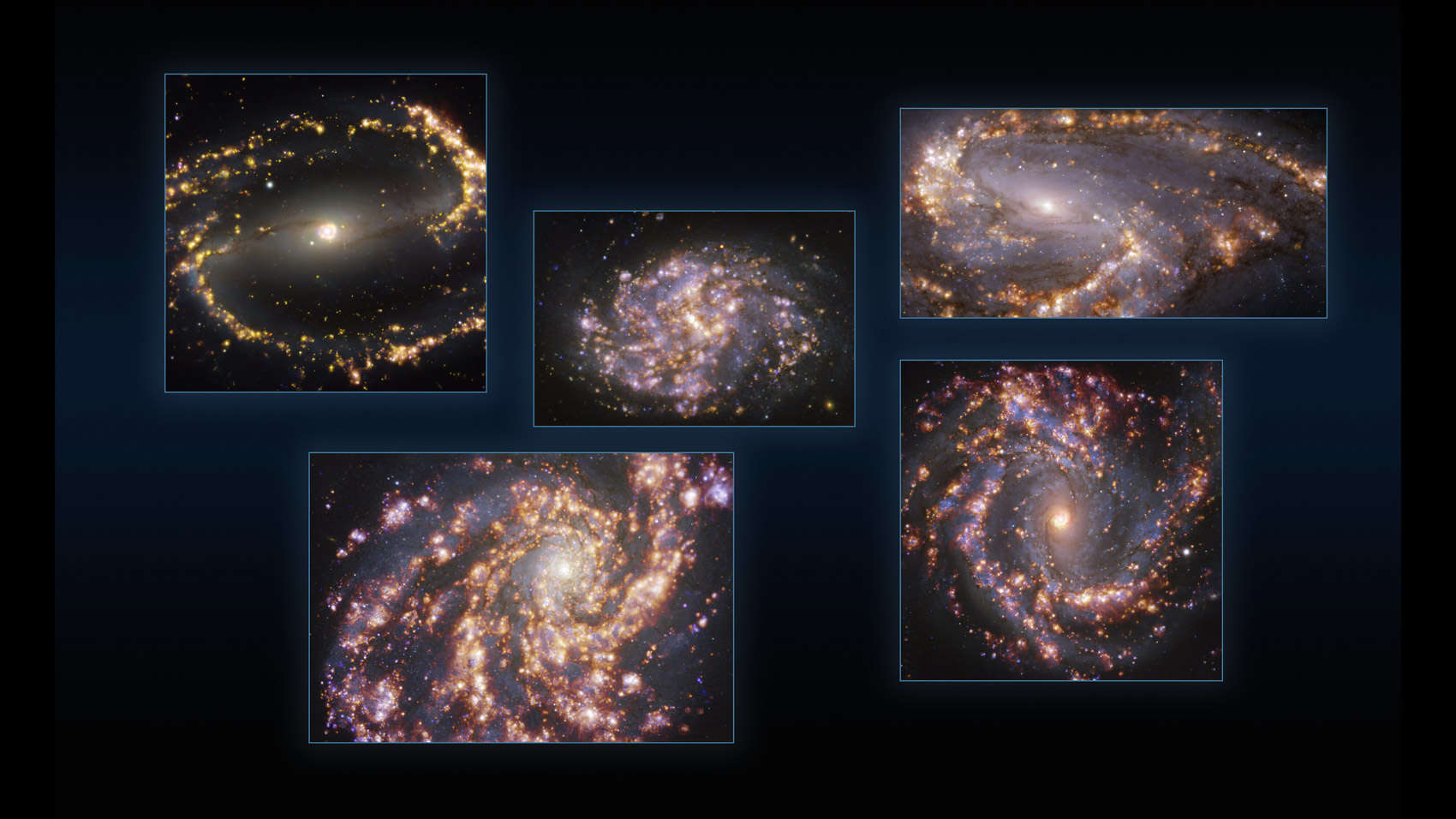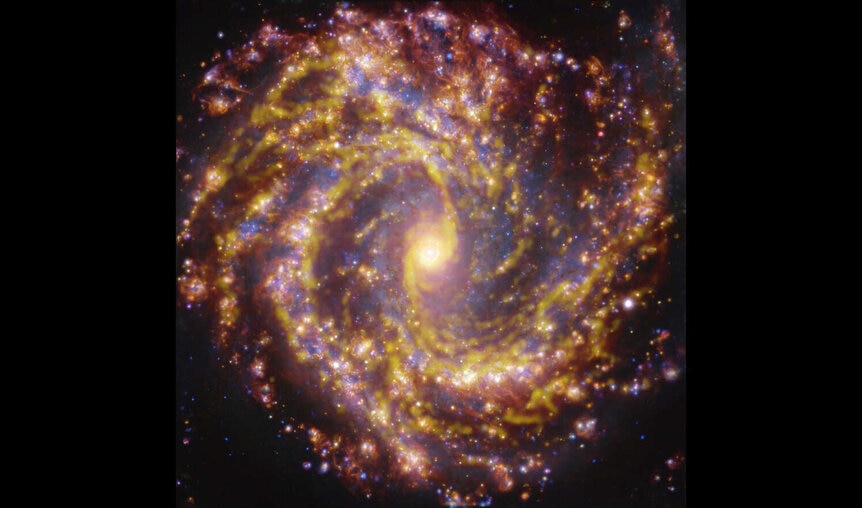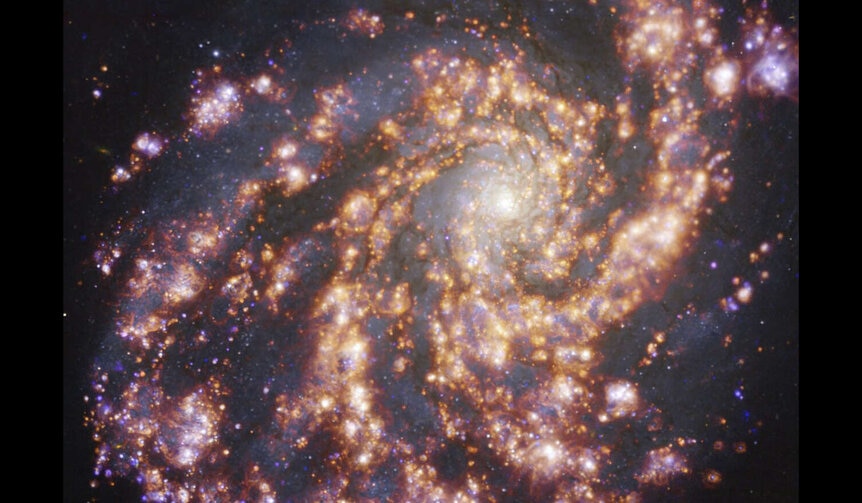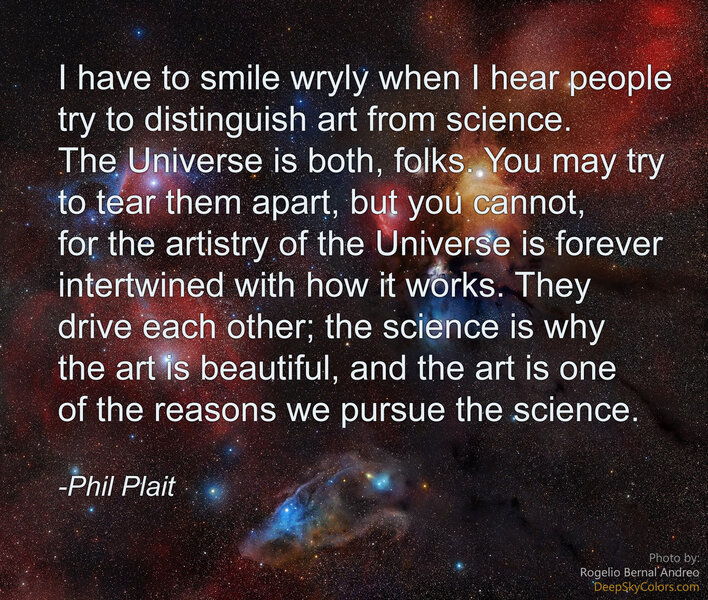Create a free profile to get unlimited access to exclusive videos, sweepstakes, and more!
How are stars born? Absolutely gorgeously. See for yourself.

How are stars born?
After millennia of wondering, astronomers are now able to answer that question, at least to a large degree. Huge clouds of gas and dust in space collapse, and clumps of denser material form which then collapse more rapidly, their own gravity compressing them until they can ignite nuclear fusion in their cores.
A star is born.
But there are still a lot of questions to answer here, scads of details to fill in. And not just details but also big-picture questions. Literally.
So 90 astronomers from 30 institutions around the world formed a team to observe nearby galaxies using some of the planet's best telescopes. These galaxies are close enough to us that we can see individual star-forming regions inside them, but also far enough that we can see the entire galaxy at the same time, getting an overview of this process.
A process that is not only complex, but also surpassingly beautiful.
The project is called PHANGS, for Physics at High Angular Resolution in Nearby GalaxieS. Literally, trying to understand the physics of star birth in nearby galaxies in detail, peering deeply into them with very sharp vision.
The scale of this project is immense. They're looking at nearly a hundred galaxies, mapping out over a hundred thousand individual star-forming nebulae. It's incredible.
There are two telescopes playing a major role here. One is ALMA, the Atacama Large Millimeter/submillimeter Array, a collection of dozens of dishes in Chile. These look at light with a wavelength of around a millimeter (much longer than visible light, the kind we see), which is emitted by cold gas. For example, carbon monoxide emits at just this wavelength, and is commonly found in dense gas clouds where star formation is imminent or ongoing.
The other is the Very Large Telescope, a set of four 8.2-meter behemoths also in Chile. The camera used is called MUSE, for Multi Unit Spectroscopic Explorer. It takes spectra, breaking incoming light up into thousands of individual colors, which can be analyzed to determine a wealth of information about an object: its elemental composition (like hydrogen, oxygen, sulfur, and so on), elemental abundances, temperature, density, and much more.
Combing ALMA and VLT/MUSE allows astronomers to investigate star birth in more detail and on larger scales than has ever been achieved before.
The beauty of these images is staggering. Spiral galaxies — essentially huge flat disks with spiral patterns in them — tend to make lots of stars, so the astronomers targeted them. Moreover, they chose ones that were more or less face-on, so that minimizes looking through the disk; this way the gas clouds are easily seen and able to be examined at high resolution without interference. This is basically a checklist for creating intensely gorgeous images.
The science they seek is profound. We do understand a lot about how stars form, but we still don't understand things like how the process gets started in the first place; what exactly triggers a cold gas cloud to collapse? Does it collide with another cloud, a cosmic smashup that crunches both in a way that they fall in on themselves and start making stars? What are the intermediate steps? Are they the same everywhere in a galaxy?
Do stars prefer being born near the centers of galaxies, or farther out? Somewhere in between? Do they form more readily on the inside curve of a spiral arm or the outside? Does the size of the gas cloud matter? Do some nebulae make more massive stars easily, stars destined to explode as supernovae? We have some general answers to these questions, but we want details.
And speaking of which, stars affect their birthplace profoundly after they're born. They blast out fast winds of subatomic particles and intense ultraviolet light that eat away at the gas and dust around them, carving enormous cavities and affecting the way other stars are born. They also eventually explode, and you can just bet that affects things. A supernova is a terrifying event, releasing as much energy in a few weeks as the Sun will over its lifetime.
Answers to these questions can only be found by looking at what's going on at both small and large scales in these galaxies, which is what PHANGS is designed to do. There was an early release of ALMA results in 2019, and then a more complete one earlier this year. This new release includes the MUSE data, which is enormous: 15 million spectra of 30,000 nebulae, a treasure of astronomical data that will be mined for many years in pursuit of this understanding.
Not only that, but many of these galaxies have been or will be mapped by Hubble Space Telescope, which provides even higher resolution, and the project will be continued with the James Webb Space Telescope, which should launch within a year. It will obtain extremely high-resolution images and spectra of these galaxies in infrared, adding yet another chunk of the electromagnetic spectrum to the data.
I love this. I'm a big fan of ambitious, sweeping astronomical surveys that are undertaken for a specific purpose but which also provide the community with a vast and deep database of observations that can be used for a wide array of other projects, many of which haven't even been dreamed up. But when some young astronomer thinks of something cool to investigate, that data will be waiting.
And I can't help it: I love it when science and art walk hand-in-hand this way. Scientists are human, and we gasp at and are awed by the beauty we see in the heavens. Observations like these will further our knowledge of the Universe around us, helping us answer big questions, like, “How did we get here?”
And they are also just seriously beautiful and wondrous.
There is beauty in science, just as there is science in art. They are two sides of the same coin.



















